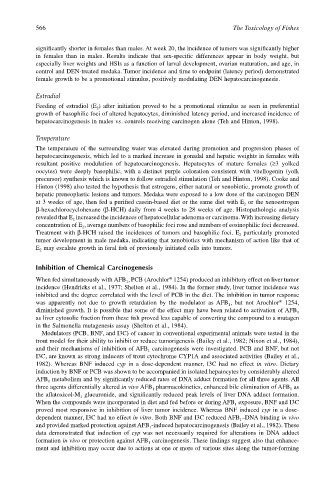Page 586 - The Toxicology of Fishes
P. 586
566 The Toxicology of Fishes
significantly shorter in females than males. At week 20, the incidence of tumors was significantly higher
in females than in males. Results indicate that sex-specific differences appear in body weight, but
especially liver weights and HSIs as a function of larval development, ovarian maturation, and age, in
control and DEN-treated medaka. Tumor incidence and time to endpoint (latency period) demonstrated
female growth to be a promotional stimulus, positively modulating DEN hepatocarcinogenesis.
Estradiol
Feeding of estradiol (E ) after initiation proved to be a promotional stimulus as seen in preferential
2
growth of basophilic foci of altered hepatocytes, diminished latency period, and increased incidence of
hepatocarcinogenesis in males vs. controls receiving carcinogen alone (Teh and Hinton, 1998).
Temperature
The temperature of the surrounding water was elevated during promotion and progression phases of
hepatocarcinogenesis, which led to a marked increase in gonadal and hepatic weights in females with
resultant positive modulation of hepatocarcinogenesis. Hepatocytes of mature females (≥3 yolked
oocytes) were deeply basophilic, with a distinct purple coloration consistent with vitellogenin (yolk
precursor) synthesis which is known to follow estradiol stimulation (Teh and Hinton, 1998). Cooke and
Hinton (1998) also tested the hypothesis that estrogens, either natural or xenobiotic, promote growth of
hepatic preneoplastic lesions and tumors. Medaka were exposed to a low dose of the carcinogen DEN
at 3 weeks of age, then fed a purified casein-based diet or the same diet with E or the xenoestrogen
2
β-hexachlorocyclohexane (β-HCH) daily from 4 weeks to 28 weeks of age. Histopathologic analysis
revealed that E increased the incidences of hepatocellular adenoma or carcinoma. With increasing dietary
2
concentration of E , average numbers of basophilic foci rose and numbers of eosinophilic foci decreased.
2
Treatment with β-HCH raised the incidences of tumors and basophilic foci. E particularly promoted
2
tumor development in male medaka, indicating that xenobiotics with mechanism of action like that of
E may escalate growth in feral fish of previously initiated cells into tumors.
2
Inhibition of Chemical Carcinogenesis
®
When fed simultaneously with AFB , PCB (Arochlor 1254) produced an inhibitory effect on liver tumor
1
incidence (Hendricks et al., 1977; Shelton et al., 1984). In the former study, liver tumor incidence was
inhibited and the degree correlated with the level of PCB in the diet. The inhibition in tumor response
was apparently not due to growth retardation by the modulator as AFB , but not Arochlor 1254,
®
1
diminished growth. It is possible that some of the effect may have been related to activation of AFB 1
as liver cytosolic fraction from these fish proved less capable of converting the compound to a mutagen
in the Salmonella mutagenesis assay (Shelton et al., 1984).
Modulators (PCB, BNF, and I3C) of cancer in conventional experimental animals were tested in the
trout model for their ability to inhibit or reduce tumorigenesis (Bailey et al., 1982; Nixon et al., 1984),
and their mechanisms of inhibition of AFB carcinogenesis were investigated. PCB and BNF, but not
1
I3C, are known as strong inducers of trout cytochrome CYP1A and associated activities (Bailey et al.,
1982). Whereas BNF induced cyp in a dose-dependent manner, I3C had no effect in vitro. Dietary
induction by BNF or PCB was shown to be accompanied in isolated hepatocytes by considerably altered
AFB metabolism and by significantly reduced rates of DNA adduct formation for all three agents. All
1
three agents differentially altered in vivo AFB pharmacokinetics, enhanced bile elimination of AFB as
1
1
the aflatoxicol-M glucuronide, and significantly reduced peak levels of liver DNA adduct formation.
1
When the compounds were incorporated in diet and fed before or during AFB exposure, BNF and I3C
1
proved most responsive in inhibition of liver tumor incidence. Whereas BNF induced cyp in a dose-
dependent manner, I3C had no effect in vitro. Both BNF and I3C reduced AFB –DNA binding in vivo
1
and provided marked protection against AFB -induced hepatocarcinogenesis (Bailey et al., 1982). These
1
data demonstrated that induction of cyp was not necessarily required for alterations in DNA adduct
formation in vivo or protection against AFB carcinogenesis. These findings suggest also that enhance-
1
ment and inhibition may occur due to actions at one or more of various sites along the tumor-forming

